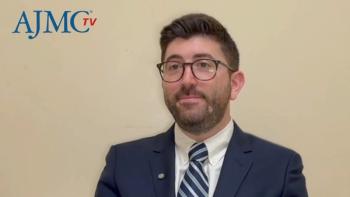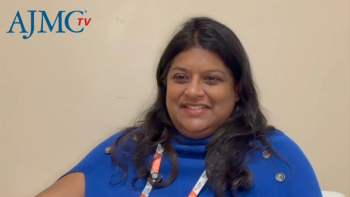
Elizabeth Colyer Discusses Nationwide Takeaways From Sharecare's Flatten the Curve Survey
Based on the respondent pool, Sharecare observed 3 core takeaways from the Flatten the Curve survey–mental well-being, the connection between health and wealth, and access to health care, said Elizabeth Colyer, senior vice president of Community Well-Being Index at Sharecare.
Based on the respondent pool, Sharecare observed 3 core takeaways from the Flatten the Curve survey—mental well-being, the connection between health and wealth, and access to health care, said Elizabeth Colyer, senior vice president of Community Well-Being Index at Sharecare.
Transcript
AJMC®: Hello, I'm Matthew Gavidia. Today on MJH Life Sciences News Network, The American Journal of Managed Care® is pleased to welcome Elizabeth Colyer, senior vice president of Community Well-Being Index at Sharecare. Can you tell us a little bit about yourself and what is the
Colyer: Absolutely, thank you so much for having me! I'm Elizabeth Colyer, I run the Community Well-Being Index at Sharecare and our Flatten the Curve survey was really about deploying a question set, as well as feedback to our respondents around really 3 or 4 core categories. One was around—based off their habits and behaviors if they were doing their part leaning in to really flatten the curve, and that was everything from whether or not individuals were being compliant to hand washing to staying at home, work from home policies, and various other mandates that we know were coming from the public’s health, as well as government sphere. So, that was 1 major category that we wanted to address.
Another was making sure that we were continuing to understand COVID-19 transmission, symptoms and rates, as well as habits that individuals were taking when they were experiencing symptoms. Everything from whether or not they were still exposing themselves to others if they were physically distancing, and how they were accessing care at that time. The last 1 core category as a foundational part to our philosophy, and really Jeff Arnold's
So, just a few examples of that—so, again, we never just want data for data sake, we always want to be able to apply that to an intervention. So, just to give a few examples of that, when we saw in the survey that 9 of 10 individuals were experiencing some form of worry regarding COVID-19, 66% or 2 of 3 respondents indicated that they were seeing or feeling some sort of financial worry regarding their retirement funds in the market overall. We worked with our partner, which is now actually a company that's part of the Sharecare family, MindSciences, to deploy their Unwinding Anxiety® program for free for consumers starting in Arizona for 90 days. Again, just making sure that we're relating what we're seeing in the data to actually an intervention that will improve individuals access to care and well-being.
Another example of that was we saw that 60% of respondents indicated that they would prefer to seek care with their primary care physician. So, a lot of the telemedicine offerings that were out there were with providers that somebody doesn't already know and doesn't already trust, and we know that trust is a huge part of the health care system. So, we deployed a telehealth solution that really encouraged getting providers on the platform and to ensure that more providers were using digital means to be able to connect with individuals. Then, again, I think I could just continue to go on and on with sort of the results and how we tried to align protocols to that, but that's really our goal with Flatten the Curve was to understand what were the core needs, were people doing their part, what symptoms are they experiencing to ensure that we could align those to interventions that exist within the Sharecare ecosystem, as well as deploying new capabilities for consumers and for our enterprise partners.
AJMC®: Can you tell us about the Sharecare Well-Being Index, the partnership with Boston University School of Public Health, and the purpose of the Flatten the Curve Survey?
Colyer: Yeah, absolutely. So, well-being is foundational to everything that we do at Sharecare, and where that started really was in 2007. Actually a company we acquired, Healthways, commissioned a study with Gallup to really move beyond analyzing just physical factors of well-being and really understand the non-physical factors most critical when it comes to major health outcomes that we know both individuals and our clients care about. What manifested from that study was the 5 elements of well-being. So, that's physical well-being, financial well-being, social, community, and purpose. So, over the course of 10 years we studied well-being, we have longitudinal data that's representative of 95% of the United States population, and truly the ability to contextualize individual risk factors and perceptions; but what we noted, what Jeff Arnold noted was that there was a missing component to that, and so we partnered with the Boston University, Dr. Sandro Galea is the head of their School of Public Health, partnered with them to create a next generation index.
So, we've spent about 9 months with their
So, this summer, we'll be deploying a combined index that capitalizes on that intellectual property that we've generated through well-being, again, tons of peer-reviewed publications and understanding around well-being significance when it comes to everything from health care utilization to macroeconomic indicators like the S&P 500, combining that with our social determinants index to create a single variable and a single ranking in community well-being. Again, contextualizing somebody's individual well-being plus the circumstances of where they live, work, and play.
So, when we think about that, relative to what I just described around the Flatten the Curve survey, again, this is something that we're working towards this summer not only to understand what it was like pre-COVID-19, what was the state of our well-being at that time, but how have we seen that trend from October to date, October of last year to date, anticipating some declines, which we'll talk about why, but flatten the curve was really an interim approach as we move towards that ranking’s release to in very short order understand the needs of individuals and respondents across the country so that we can deploy those interventions. Again, as we prepare for a much broader release that will truly contextualize our pre-COVID-19 well-being status, as well as sort of how we've trended based off of the COVID-19 pandemic to date.
AJMC®: What are the top takeaways of the Flatten the Curve results from a nationwide perspective?
Colyer: So, the first thing I say as a quasi statistician, mostly analyst is that we recognize these are not representative results. Our Community Well-Being index is representative, but we did have a very, very large respondent pool. Over 115,000 people have taken the survey to date so we do feel very strongly that we saw a sample size that was significant in at least contextualizing some of what our country's experiencing. I think there was probably 3 core things that I would call out, while there was a ton of things that came out of this survey, there's probably 3 that I would call out specifically.
One, I mentioned already, which was the mental well-being component of this, it cannot be discounted. Nine of 10 respondents, indicated they're experiencing some form of worry regarding COVID-19, and the 2 of 3 or the 66% is the percentage of individuals experiencing some form of financial worry regarding their retirement funds in the market overall. So, that's huge, right? That amount of worry, in particular, and again, it's not a 1 to 1 comparison, but in particular, when you look at our most recent Community Well-Being Index released where 38% of the United States’ population typically experiences some form of worry—that's a huge increase. That's something, even if it's estimated.
So, that's something that was hugely profound when it came to these results. Relevant to that, and looking at the connection between health and wealth, we saw that about a third of respondents were experiencing 1 of 3 financial stressors that we analyzed. So, beyond just broad financial worry, which I've just mentioned, there's sort of 3 financial stressors that are within contingency with Boston University that we dug into a little bit deeper. Those were issues with paying your bills, decreases in pay, and likelihood to lose your job, and about a third of people exhibited at least 1 of those, our respondents exhibited 1 of those financial stressors. What was pretty amazing was that of the people, any of those financial stressors created a much higher likelihood of also having a negative health behavior change. What we mean by that is that if you were experiencing—you had a decrease in pay, you lost your job already or you thought it was likely to lose your job, or you thought you're going to have issues with paying bills–that you either were eating less healthy, that you are sleeping less, that you are exercising less, that you are drinking more, or that you are smoking and vaping more. So, again, that incredible connection between health and wealth, I think was a major finding, again that we explored in contingency or in concert with Boston University.
Then I'd say that the last thing was really around access. I think it was pretty profound to see individuals indicating their likelihood of wanting to go see a PCP. Seeing that 67% of people were still going to the grocery store, to restaurants to get takeout. Again, these necessary things that were still keeping us moving in leaving the house and that we knew was still significant when it comes to the risk of COVID-19 transmission and social distancing. Again, we can't totally social distance just because of a lot of these necessary sort of components. So, I'd say those were sort of 3 major themes that stuck out to us. Those again, were a lot of what drove us to put an anxiety program that's free for consumers in concert with Blue Cross Blue Shield of Arizona to spin up a telehealth platform, and also to really think a lot harder about expanding and augmenting against our financial well-being suite of offerings.
Newsletter
Stay ahead of policy, cost, and value—subscribe to AJMC for expert insights at the intersection of clinical care and health economics.









































